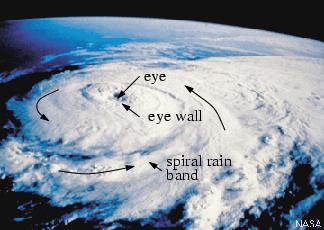Tropical Cyclones (Hurricanes)
A tropical cyclone is a rotating, organized system of clouds and thunderstorms that originates over tropical or subtropical waters and has a closed low-level circulation. Tropical cyclones rotate counterclockwise in the Northern Hemisphere. The Atlantic hurricane season runs from June 1st to November 30th, however, these storms can develop before or after the season.
Conditions Which Must Be Present in the Development of a Tropical Cyclone:
1.Low-pressure system;
2.Warm temperatures over the Ocean;
3.Moist environment (precipitation);
4.Tropical wind patterns over the equator.

Anatomy of a Hurricane
Hurricanes are a triple threat bringing high winds, soaking rain, and flying debris. Hurricanes can cause devastation and property destruction on a massive scale, making proper disaster mitigation and well-planned response all the more important. While all coastal areas are at risk for hurricanes, Louisiana is particularly vulnerable.
In addition, hurricanes are capable of causing flooding and damage hundreds of miles inland.
Eye: The eye is the "hole" at the center of the storm. Winds are light in this area. Skies are partly cloudy, and sometimes even clear.
Eye wall: The eye wall is a ring of thunderstorms. These storms swirl around the eye. The wall is where winds are strongest and rain is heaviest.
Rain bands: Bands of clouds and rain go far out from a hurricane's eye wall. These bands stretch for hundreds of miles. They contain thunderstorms and sometimes tornadoes.

Comment list ( 0 )
